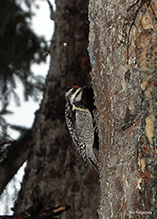Yellow-bellied Sapsucker
(Sphyrapicus varius)
Conservation • Description • Habitat • Ecology • Distribution • Taxonomy
|
|
||||||||||||||
Description |
Yellow-bellied Sapsucker medium-sized woodpecker has a name likely to elicit a smile or a raised eyebrow. It is 7″ to 9″ long, weighs 1½ oz. to 2 oz., and has a 13″ to 16″ wingspan. The back is black with extensive narrow white barring. The belly is yellowish. The flanks are yellowish to white with narrow faded barring. The breast is black. The rump is white. The wings are black with narrow white bars and a large white patch that is conspicuous during flight. The tail is mostly black. The head is mostly black and white and boldly striped. The crown is bright red. On the male the chin is bright red. On the female it is white. |
Size |
7″ to 9″ in length 16″ wingspan |
Voice |
|
|
A repeated, scratchy, nasal, cat-like me-ew. The drumming is a loud roll quickly slowing to rapid but clearly separated taps and finished by 3 or 4 well-spaced taps at the end. |
Sign |
Long, horizontal, more or less straight lines of small, closely-spaced holes in the trunk of a tree are a sure sign of this bird. |
Similar Species |
Pileated Woodpecker (Dryocopus pileatus), the only other woodpecker in Minnesota with a red crown, is a much larger, much blacker bird. |
Habitat |
Young, deciduous and mixed forests, especially dry, second-growth woodlands |
Ecology |
Migration |
Late March to late October |
Nesting |
In late April and May the male and female excavate a nest hole in a live poplar or birch tree 6½′ to 65′ above the ground. They will often choose a dead limb or a trunk with decayed heartwood. Excavation takes from 2 to 3 weeks. The finished nest will be up to 10″ deep with an entrance hole only 1½″ in diameter. The nest is not lined. The female lays 4 to 7 eggs on wood chips left over from the excavation. Both adults share incubation duties. The eggs hatch in 12 to 13 days. The young leave the nest 25 to 29 days after hatching. There is only one brood per year. Nests are often reused year after year. |
Food |
Tree sap and small insects attracted to the sap filling the holes made by the bird. Also hammers for insects and catches insects on the wing. |
Distribution |
Occurrence |
Common migrant and breeder |
Maps |
The Minnesota Ornithologists’ Union All Seasons Species Occurrence Map |
Taxonomy |
|
Class |
Aves (birds) |
Order |
Piciformes (woodpeckers, barbets, toucans, and honeyguides) |
Family |
Picidae (woodpeckers) |
Subfamily |
Picinae |
Genus |
Sphyrapicus (sapsuckers) |
Subordinate Taxa |
|
Four subspecies have been described. Two have been raised to full species status; one is now a considered a synonym, and one is no longer considered valid. No subspecies are currently recognized. |
|
Synonyms |
|
Picus varius Sphyrapicus varius appalachiensis Sphyrapicus varius varius |
|
Visitor Photos |
||
Share your photo of this bird. |
||
This button not working for you? |
||
Lynn Rubey |
 |
A male Yellow-Bellied Sapsucker, the only Minnesota woodpecker with a red chin patch. |
Bill Reynolds |
||
 |
 |
|
MinnesotaSeasons.com Photos |
||
 |
 |
|
| Sign | Sign |
|
 |
||
| Sign |
|

Slideshows |
Yellow-bellied sapsucker |

|
About
Sphyrapicus varius |
Yellow-bellied Sapsucker |

|
Yellow-bellied Sapsucker |

|

Visitor Videos |
||
Share your video of this bird. |
||
This button not working for you? |
||
|
Other Videos |
||
Yellow bellied Sapsucker, Sphyrapicus varius drilling holes. |
About
Published on Jun 26, 2014 Yellow-bellied Sapsucker,Sphyrapicus varius, feeding |
Yellow-bellied sapsucker female. South Padre Island |
About
Published on Apr 4, 2015 Recorded at Valley land fund lots South Padre Island Birding and Nature Center on 2015-03-28 Sphyrapicus varius Chupasavia Maculado, chupasavia norteño (Spanish) If you want to watch similar bird and other wildlife videos go to my YouTube channel at http://www.youtube.com/user/tavovalero/videos |
Yellow-bellied Sapsucker (Picidae: Sphyrapicus varius) Male |
About
Uploaded on Jun 26, 2010 Photographed at the Rydell NWR, Minnesota (25 June 2010). |
Yellow-bellied Sapsucker (Sphyrapicus varius) |
About
Published on Sep 27, 2012 Filmed in an aspen forest in central Alberta. |
Sphyrapicus varius Yellow-bellied Sapsucker at wells |
About
Uploaded on Jul 18, 2011 No description available. |

Visitor Sightings |
||
Report a sighting of this bird. |
||
This button not working for you? |
||
Ellen Hawkins |
Location: Grand Marais, Cook County A young one has been coming to our shelled peanuts for about 2 weeks |
|
| Lynn Rubey 6/11/2019 |
Location: Big Stone National Wildlife Refuge A male Yellow-Bellied Sapsucker, the only Minnesota woodpecker with a red chin patch. |
 |
Susan Torkelson |
Location: Adams health Care Center |
| Debbie lamp here 4/22/2017 |
Location: 5 miles south of hibbing on bunker road feeding on suet in yard have also been seeing a red bellied woodpecker yesterday feeding on suet. The downy and hairy woodpeckers commonly feed here |
|
| Bill Reynolds 6/6/2015 |
Location: Pennington Co MN Here is a closer look at the Yellow-bellied Sapsucker. Such a good looking fellow. |
 |
| Bill Reynolds 4/30/2011 |
Location: Pennington Co. |
 |
MinnesotaSeasons.com Sightings |
||

|
Created: Last Updated: © MinnesotaSeasons.com. All rights reserved. |